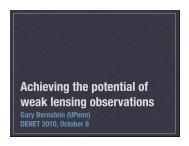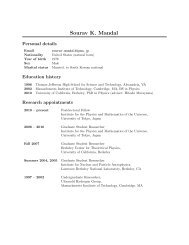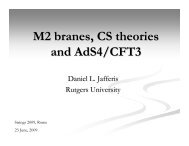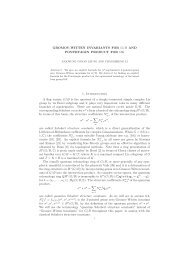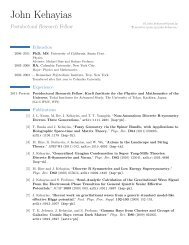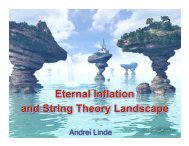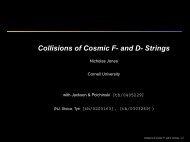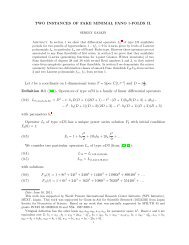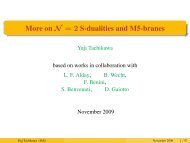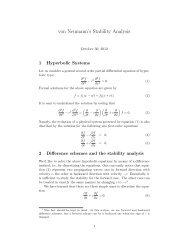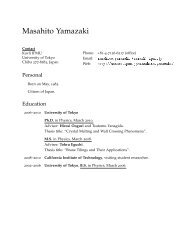STUDY SUMMARY - IPMU
STUDY SUMMARY - IPMU
STUDY SUMMARY - IPMU
You also want an ePaper? Increase the reach of your titles
YUMPU automatically turns print PDFs into web optimized ePapers that Google loves.
<strong>SUMMARY</strong> REPORT<br />
WIDE FIELD FIBER-FED OPTICAL<br />
MULTI-OBJECT SPECTROMETER (WFMOS)<br />
2.0 Scientific Case and Requirements<br />
2.1 Context<br />
We can trace the motivation for an ambitious wide field, multi-fiber spectrograph such as<br />
WFMOS to the early days of Gemini when the scientific promise of an f/6 Cassegrain focus on<br />
Gemini-South was being enthusiastically promoted by various members of the UK, US, and Canadian<br />
communities. The f/6 secondary and its associated wide field corrector were eventually<br />
eliminated for financial reasons. However, the huge impact of galaxy surveys conducted using<br />
multiplexed spectrographs on wide field 2.5–4 m telescopes such as SDSS and the AAT later<br />
resurrected the need for an equivalent facility on an 8-m aperture telescope. The discovery of<br />
dark energy in the late 1990s and the recognition that baryonic acoustic oscillations provide a<br />
valuable tracer of the cosmic expansion, independently of supernovae, has given the issue further<br />
impetus. The aim of this proposal is to make the strongest possible case for proceeding with the<br />
construction of WFMOS, in collaboration with our Japanese colleagues.<br />
Our starting point in this study was the valuable Feasibility Study (FS) conducted by a consortium<br />
led by the Anglo-Australian Observatory. Gemini, Subaru, and the Gemini Board concluded<br />
such a facility should be installed at the prime focus of the Subaru telescope where it<br />
could share the optics destined for the (then proposed, now funded) HyperSuprime Camera<br />
(HSC). The FS study proposed a range of ambitious surveys motivated by questions in both dark<br />
energy and Galactic science. These questions, in turn, followed discussions by the Gemini community<br />
at the Aspen meeting in June 2003.<br />
We have revised the science strategy proposed in the FS and, as a consequence, significantly<br />
improved the design of the instrument. Recognizing that HSC is now funded, we have put considerable<br />
emphasis on harnessing the synergy between these two wide-field instruments. We<br />
have also reassessed the role that WFMOS should play in dark energy studies. When the FS was<br />
published, WFMOS was a rare example of a facility semi-dedicated to probing dark energy. Today,<br />
there are a number of potential probes using various methods with at least three (AAT WiggleZ,<br />
SDSS-3 BOSS and the Hobby Ebberley HETDEX) proposing a major spectroscopic effort<br />
using baryonic acoustic oscillations. In the future there is optimism for one or two space missions<br />
dedicated to studying dark energy. Likewise, experience and progress with Keck’s DEI-<br />
MOS spectrograph and the ESO VLT’s FLAMES spectrograph has significantly shaped our<br />
thinking of the optimum parameters for Galactic science.<br />
One thing has not changed since the FS. Subaru remains the unique platform for an instrument<br />
like WFMOS. Investigations by others have shown that such an ambitious wide field spectrograph<br />
could not be accommodated at Keck or the VLT. Short of building a dedicated widefield<br />
telescope, WFMOS on Subaru is the only route to achieving the science goals discussed in<br />
this proposal.<br />
The unique capabilities of the Subaru prime focus raise the important question of the attitude<br />
of the Japanese community to WFMOS. Through active discussions and Japanese membership<br />
of both WFMOS teams, this question has been brought into sharp focus over the past few years,<br />
culminating in two major conferences—Panoramic Views of Galaxy Formation and Evolution<br />
(Hayama, December 2007) and Cosmology Near and Far—Science with WFMOS (Kona, May<br />
2008). Recognizing the unique synergy between HSC and WFMOS on their national telescope,<br />
the Japanese community views WFMOS as a general resource whose scientific impact should<br />
extend well beyond that envisaged by the Aspen process or the FS. To address this, we co-opted<br />
a group of 5 Japanese extragalactic astronomers enthusiastic about using WFMOS for programs<br />
6



